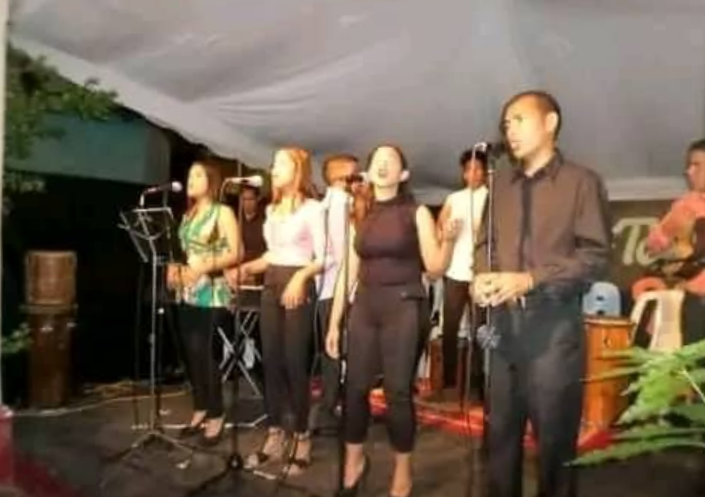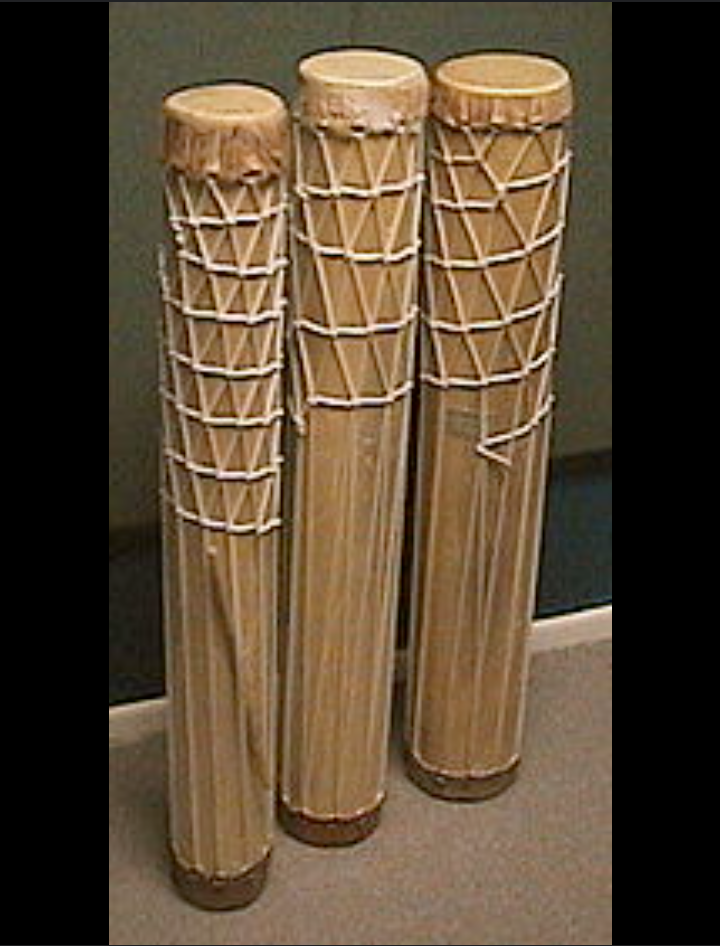Hola compañeros les envío un fuerte abrazo, hace unos días estuve escuchando una canción muy linda con sonidos espectaculares, ella se titula Está lloviendo en Caracas, el grupo que la interpreta se llama Vasallos del sol tuve la oportunidad de escucharla en vivo pero la cantaron otra agrupación está fue la Afro, que divina es esa canción

En el se usan el tambor Culo e puya llamado también tambor redondo el cual se interpreta en varios pueblos de la región de Barlovento de dicho estado (Curiepe, Mendoza, Panaquire, Tacarigüa, Tacarigüita, Higuerote y otros).
Este tambor se interpreta con la batería de tambores culo e puya: la prima que es el tambor de sonido más agudo y lleva el tiempo (velocidad) del toque. El cruzao de sonido un poco más grave completa la base rítmica junto con la prima, lleva el tiempo pero también puede improvisar (florear o echar). El pujao es el de sonido más grave y va constantemente improvisando sobre una base que se ensambla con los otros dos. Estos tambores son cilíndricos hechos de madera liviana (Lano) y con cuero de venado o pereza. Se tocan apoyando un extremo en el piso y montándolo como "en caballito" percutiéndolo con una pequeña vara y la mano. Como su sonido no es tan poderoso como el de los clarines o los cumacos de otras regiones este tambor se canta y se baila en círculo rodeando a los tocadores y se acompaña con una o varias maracas. Los toques y tonadas varían de pueblo en pueblo siendo los más emblemáticos el de Curiepe que es un poco más cadencioso y el de Mendoza que es muy veloz.

Esos son los tambores Culepuya. El Mina es un tambor cilíndrico de madera, de uno o dos metros de largo con sólo un parche o membrana sujeta con bejucos o cuerdas que forman un arco que se sostiene a su vez con cuñas de madera incrustadas en el cuerpo del instrumento que, además de sujetar, se utilizan para templarlo. Este gigantesco tambor se apoya sobre una horqueta formada por dos palos cruzados que se denominan equis, tijereta o cruz de San Andrés, de manera que la boca del membráfono queda a la altura de la boca del hombre que le percute por medio de dos pequeños palos de araguaney conocidos con el nombre de “laures” y el otro extremo de dicho instrumento descansa en tierra. El ejecutante golpea rítmicamente el cuero del Mina y a esta percusión se superpone el constante toque sobre el cuerpo del tambor, a cargo de dos ayudantes que igualmente utilizan un par de “laures” cada uno, con los cuales combinan el tono por la alternancia de las manos o se practica un solo ritmo con dichos palos tocados al unísono.
A los toques de estos tambores grandes se incorpora la voz del solista que alterna con el coro, al mismo tiempo que se suman los silbatos de gururas y los cascabeleos rítmicos de las maracas.
Una vez establecido el encendido de estos dos membráfonos, surge el alegre acompañamiento de los “laures” que golpean secamente sobre el cuerpo del Mina. Estos instrumentos se fabrican con madera de aguacate o guayabo. Tanto el Mina como el Curbata lo percuten de pie los ejecutantes.
La batería de tambores redondos denominados “culo ‘e puya” consta de tres membráfonos alargados y de escaso perímetro, con pequeñas diferencias de tamaño entre uno y otro ejemplar, y consta siempre de dos parches. Los culo ‘e puyas, además de la denominación general, reciben cada uno de ellos un nombre que los distingue, a saber: Corrío, Cruzao y Pujao.
A veces es suficiente con ajustar estas últimas. Antes de empezar a percutir el Corrío o Prima, se templa primero; el Cruzao se afina de manera que permanezca un poco más bajo y finalmente se templa el Pujao.
A ellos se les une un instrumento más llamado la lluvia demasiado bello. Los tambores redondos se acompañan con una maraca que suenan los mismos cantores, y sobre sus fondos rítmicos se entonan además diversos toques de tambor, en cuyas versificaciones alternan solistas y coros.
Lo cierto es que escuchar esa parte de la canción que dice: "Se mojan las calles con agua del cielo, y miro en silencio que bien, me hace sentir" . No les ha pasado, algo así, que cuando llueve y estamos en casa que nos quedamos mirando como cae la lluvia, se siente bien nos relaja, aunque aveces cuando llueve y tenemos que salir pues queremos que pare la lluvia, que contrariedad.
Espero que busquen está canción y puedan escuchar saludos hasta otra oportunidad.
Traducción en inglés
Hello comrades I send you a big hug, a few days ago I was listening to a very nice song with spectacular sounds, it is called Está lloviendo en Caracas, the group that plays it is called Vasallos del sol I had the opportunity to listen to it live but another group sang it, this was Afro, how divine is that song.

The drum Culo e puya, also called tambor redondo, is played in several towns in the Barlovento region of the state (Curiepe, Mendoza, Panaquire, Tacarigüa, Tacarigüita, Higuerote and others).
This drum is played with the culo e puya drum set: the prima which is the drum with the highest pitched sound and carries the tempo (speed) of the playing. The cruzao, which has a slightly deeper sound, completes the rhythmic base along with the prima, keeps time but can also improvise (flore or echar). The pujao is the one with the deepest sound and is constantly improvising on a base that is assembled with the other two. These drums are cylindrical, made of light wood (Lano) and deer or sloth leather. They are played by resting one end on the floor and riding it like "en caballito" percussing it with a small stick and the hand. As its sound is not as powerful as that of the clarinets or the cumacos of other regions, this drum is sung and danced in a circle surrounding the players and is accompanied by one or several maracas. The toques and tunes vary from town to town, the most emblematic being the one of Curiepe, which is a little more cadenced, and the one of Mendoza, which is very fast.

These are the Culepuya drums. The Mina is a cylindrical wooden drum, one or two meters long with only one drumhead or membrane fastened with bejucos or strings that form an arc that is held in turn with wooden wedges embedded in the body of the instrument that, in addition to holding, are used to temper it. This gigantic drum rests on a fork formed by two crossed sticks that are called equis, tijereta or cross of San Andrés, so that the mouth of the membráfono is at the height of the mouth of the man who hits it by means of two small sticks of araguaney known with the name of "laures" and the other end of this instrument rests on the ground. The performer rhythmically hits the leather of the Mina and to this percussion is superimposed the constant touch on the body of the drum, in charge of two assistants who also use a pair of "laures" each one, with which they combine the tone by the alternation of the hands or a single rhythm is practiced with these sticks played in unison.
The soloist's voice is incorporated to the playing of these large drums, alternating with the chorus, while the whistles of the gururas and the rhythmic rattling of the maracas are added.
Once the ignition of these two membráfonos is established, the joyful accompaniment of the "laures" arises, which strike dryly on the body of the Mina. These instruments are made of avocado or guava wood. Both the Mina and the Curbata are played standing up by the performers.
The drum set of round drums called "culo 'e puya" consists of three elongated and small-perimeter membraphones, with small differences in size between one and another specimen, and always has two drumheads. The culo 'e puyas, besides the general denomination, receive each one of them a name that distinguishes them, namely: Corrío, Cruzao and Pujao.
Sometimes it is sufficient to adjust the latter. Before starting to percuss the Corrío or Prima, it is first tuned; the Cruzao is tuned so that it remains a little lower and finally the Pujao is tuned.
They are joined by one more instrument called the Rain too beautiful. The round drums are accompanied by a maraca played by the singers themselves, and over their rhythmic backgrounds, various drum beats are also intoned, with soloists and choirs alternating in their versifications.
The truth is that listening to that part of the song that says: "The streets get wet with water from the sky, and I look in silence how good it makes me feel". It has not happened to them, something like that, that when it rains and we are at home we stay watching how the rain falls, it feels good, it relaxes us, although sometimes when it rains and we have to go out, we want the rain to stop, what a disappointment.
I hope you look for this song and you can listen to it, greetings until another opportunity.
Congratulations @evilysm! You have completed the following achievement on the Hive blockchain And have been rewarded with New badge(s)
Your next payout target is 250 HP.
The unit is Hive Power equivalent because post and comment rewards can be split into HP and HBD
You can view your badges on your board and compare yourself to others in the Ranking
If you no longer want to receive notifications, reply to this comment with the word
STOPTo support your work, I also upvoted your post!
Check out our last posts:
Support the HiveBuzz project. Vote for our proposal!
Hola Saludos he escuchado también esa canción, me llamo mucha la atención, eran tiempo de bastante lluvia en la zona donde trabajé. Sobre todo por lo que causa
Toca siempre lo mismo